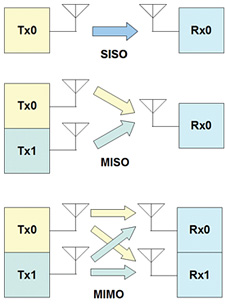Antennas for Next-Generation Digital Broadcasting

This month I'll look at some of the antenna technologies being considered for future broadcasting systems, their benefits, and how this technology is likely to be implemented in the real world.
Today broadcasters use one antenna to transmit to receivers with one antenna input, a single-input/single-output (SISO) system. WiFi routers using 802.11n technology use multiple transmitters and antennas to send data to WiFi devices with multiple antennas and multiple receivers, a multiple-input/multiple-output (MIMO) system.
MIMO & MISO
The benefits of MIMO are greater robustness and higher data capacity (efficiency). At broadcast TV frequencies, particularly VHF, it is more difficult to obtain the isolation required between the multiple receive antennas, but testing has shown there is still some benefit to be obtained using multiple transmit antennas and a single receive antenna, a MISO system, (see Fig. 1). The transmitted signals in MIMO and MISO systems have to be encoded so that the receiver can identify each transmitted signal. This is typically done using pilot signals with orthogonal patterns for each antenna.

Fig. 1: A MISO system consists of multiple transmit antennas and a single receive antenna. By encoding the data sent to the different transmitters and antennas, it is possible to increase the data capacity and robustness of the channel. Alamouti space-time coding is one way to achieve these benefits in a MIMO or MISO system (for an explanation of Alamouti coding, Google "Space Time Code for MIMO Systems," by Fernando Gregorio at Helsinki University of Technology).
Alamouti coding, however, does not handle Doppler very well. Golden code, a full rate, full diversity 2x2 linear dispersion space time block code, is another option, (Google "Applications of the Golden Code"). There may be benefits in using Golden codes for space-frequency coding, (Google "Golden Codes for Dual Polarized MIMO-OFDM Transmissions in Hybrid Satellite/Terrestrial Mobile Systems").
In a MIMO or MISO transmission system, the environment between the transmitter and the receiver has a significant effect on performance. Adding multipath improves performance because it increases the difference between the multiple transmitted signals as they follow different paths between reflecting surfaces or bend over obstacles. There are also trade-offs between robustness and data capacity. These factors complicate evaluation of different transmission systems and coding techniques. Improvements around 3 dB in SNR and a 30 percent or more increase in data bandwidth are typically quoted for MIMO/MISO systems over SISO.
A Google search will bring up multiple studies on MISO/MIMO technology with DVB-T2 signals. One I found particularly interesting was "A 2x2 MIMO DVB-T2 System: Design, New Channel Estimation Scheme and Measurements with Polarization Diversity," by Carlos Gómez-Calero, Luis Cuéllar Navarrete, Leandro de Haro and Ramón Martínez. The study, conducted at the Universidad Politécnica de Madrid, Spain, compares use of multiple antennas with different polarities—two separated horizontally polarized antennas, two vertically polarized antennas, or one horizontally polarized—and one vertically polarized antenna. It is interesting to see that the H/V combination performs well in both line of sight and non-line of sight conditions. Fig. 2 from this paper shows general scheme of the MIMO test bed and Fig. 3 is a block diagram of the transmitter. The paper has more details on the system.

Fig. 2: General scheme of the MIMO test bed The Universidad Politécnica de Madrid results agree with the findings of a test done by Galtronics with a DAS in Las Vegas. Their H/V dual polarized antenna performed better than multiple antennas with a single polarization, allowing the use of fewer antennas and improving data capacity in areas close to the antenna with less multipath.
The BBC has published a white paper on "A simple model of the UHF cross-polar terrestrial channel for DVB-NGH," that has pictures showing a 2x2 MIMO system using separate H and V polarized panel antennas on the transmit end. There is little data on measured performance but it shows how MIMO could be used in broadcasting.

Fig 3: Block diagram of MIMO test bed transmitterREPLACING THE 'BIG STICK'
If the U.S. transitions to a new transmission technology that supports MIMO/MISO technology, how would it be implemented at stations? One way would be to use multiple transmitter sites with overlapping coverage in an SFN. While this may work well for filling in gaps in coverage or expanding coverage, it would be difficult and expensive to fit into our existing "single stick" broadcast infrastructure.
The simplest solution would be to add a vertically polarized antenna, perhaps a broadband panel array that could be shared by multiple stations, to an existing horizontally polarized antenna, with the two antennas fed by separate transmitters. This would not be the same as feeding separate H and V polarized antennas from the same transmitter, which results in slant polarization, because the each antenna would have a different signal.
Another option would be to use a dual input panel antenna such as RFS's PEP or PCP. For conventional SISO broadcasting, the two antenna inputs would be powered from one transmitter to generate one elliptically polarized signal. For future MISO or MIMO broadcasting, the inputs would be fed from two separate transmitters to provide two orthogonally polarized signals.
MISO/MIMO is available as an option in DVB-T2. DVB-NGH will depend on it to obtain the desired increase in efficiency. Use of miniature cross-polarized antennas may make MIMO practical on lower UHF channels even in handheld devices. Because MISO and MIMO are an important part of the LTE standard, I expect to see rapid development in this area. Adding MISO or MIMO technology will be much more complicated than changing from a single carrier transmission system such as 8-VSB to a multiple carrier system like OFDM, although not as complex as transmitting different signals using Orbital Angular Momentum (OAM) states (radio vorticity or "twisted" waves).
I'll discuss OAM in more detail in a future RF Technology column. At the present time, it is hard for me to see how it could be used at VHF or even UHF broadcast wavelengths and it isn't clear how well it will work in the presence of multipath, a requirement for use with mobile, portable, and hand-held devices.
Comments are welcome! Email me at dlung@transmitter.com.
Get the TV Tech Newsletter
The professional video industry's #1 source for news, trends and product and tech information. Sign up below.

Doug Lung is one of America's foremost authorities on broadcast RF technology. As vice president of Broadcast Technology for NBCUniversal Local, H. Douglas Lung leads NBC and Telemundo-owned stations’ RF and transmission affairs, including microwave, radars, satellite uplinks, and FCC technical filings. Beginning his career in 1976 at KSCI in Los Angeles, Lung has nearly 50 years of experience in broadcast television engineering. Beginning in 1985, he led the engineering department for what was to become the Telemundo network and station group, assisting in the design, construction and installation of the company’s broadcast and cable facilities. Other projects include work on the launch of Hawaii’s first UHF TV station, the rollout and testing of the ATSC mobile-handheld standard, and software development related to the incentive auction TV spectrum repack. A longtime columnist for TV Technology, Doug is also a regular contributor to IEEE Broadcast Technology. He is the recipient of the 2023 NAB Television Engineering Award. He also received a Tech Leadership Award from TV Tech publisher Future plc in 2021 and is a member of the IEEE Broadcast Technology Society and the Society of Broadcast Engineers.
